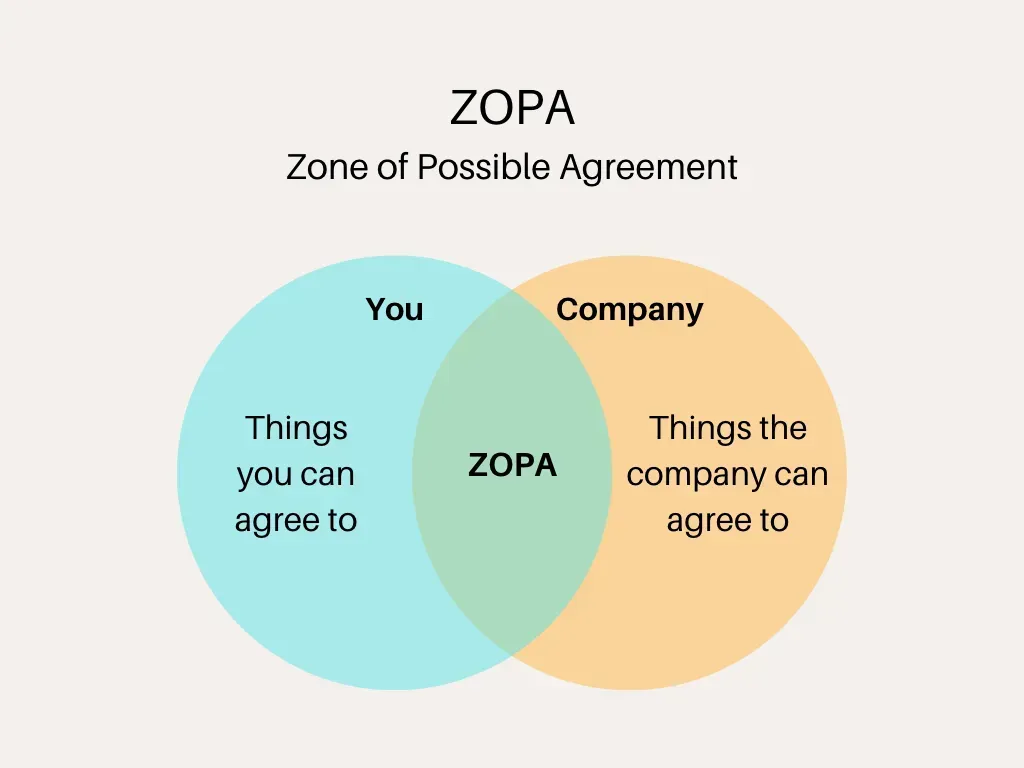
Getting Black Women Paid Blog

The Getting Black Women Paid Podcast
Blog Posts.

Negotiation 101
The 3 Key Principles to Maximize Your Earning Potential and Enhance Your Professional Journey
Are you ready to take control of your earning potential and unlock new opportunities in your professional journey?
Negotiation is a powerful skill that can help you do just that. Whether you’re seeking a higher salary, improved benefits, or a better work-life balance, understanding the key principles of negotiation is essential.
In this article, we will dive into the three fundamental principles that will empower you to negotiate effectively and secure the best possible outcomes. Get ready to transform your approach to negotiation and elevate your career to new heights!
ZOPA — Finding the Common Ground
In the intricate dance of negotiation, finding common ground is crucial. That’s where the Zone of Possible Agreement (ZOPA) comes into play. The ZOPA refers to the range or overlap between the negotiating parties' acceptable positions. It represents the space In which both parties can potentially reach a mutually beneficial agreement.

Image by the author
How It Works
The ZOPA is determined by considering each party’s desired outcomes, interests, and priorities. By finding common ground within the ZOPA, negotiators can work towards reaching a solution that satisfies both parties’ needs and maximizes the value of the agreement.
Example
You are negotiating a new role with a potential employer. The salary range for the position is $60,000 to $70,000 per year, and you have a desired salary of $65,000 or higher. The ZOPA is the range between $65,000 and $70,000, where both parties can potentially reach a mutually acceptable agreement on the salary.
BATNA — Your Fallback Position
Have you ever wondered what your options are if negotiations fall through? That’s where the concept of the Best Alternative to a Negotiated Agreement (BATNA) becomes invaluable. Your BATNA is your fallback position, the course of action you will pursue if the negotiation fails to meet your expectations.

Image by the author
How It Works
By assessing and understanding your BATNA, you gain clarity and leverage during negotiations. This BATNA is crucial because it provides you with a point of comparison. If the proposed agreement is less favorable than your BATNA, it may be in your best interest to walk away from the negotiation. Conversely, if the proposed agreement is better than your BATNA, it is likely a favorable outcome for you.
Example
In the negotiation for a new role, your BATNA might be considering other job offers or exploring alternative opportunities. If the employer’s offer falls below your BATNA, it may be in your best interest to walk away from the negotiation and pursue other options.
Win-Win — Collaboration for Success
Negotiation doesn’t have to be a zero-sum game. In fact, a win for both parties is not only possible but highly desirable! Enter the Win-Win approach, where collaboration and problem-solving take center stage. The goal is to create value and satisfy the interests of both parties involved, rather than seeking a win at the expense of the other party.

Image by the author
How It Works
Win-Win negotiations emphasize problem-solving, open communication, and exploring creative options. By seeking mutually beneficial solutions, you can build positive relationships, foster long-term cooperation, and create value that extends beyond monetary gains.
Example
When negotiating an offer for a new role, a Win-Win approach could involve exploring various aspects beyond salary, such as bonuses, paid time off, remote work flexibility, and other benefits. For example, you could propose a slightly lower salary than your initial ask in exchange for a signing bonus, additional vacation days, or the option to work remotely a few days a week. This approach aims to find a mutually beneficial solution where both parties feel they have gained value and their needs are met.
Tying It All Together
By mastering these three key principles — ZOPA, BATNA, and Win-Win — you will develop a solid foundation for negotiation success. In the upcoming article, “Negotiation 102: Seven Strategic Moves to Secure a Higher Salary and Improved Benefits,” we will delve further into actionable strategies and techniques to enhance your negotiation prowess.
Get ready to take your negotiation skills to the next level and secure the rewards you deserve. Your professional journey awaits!
For weekly inspiration and tips on how to claim yours, sign up for my newsletter here.
For more on financial independence, check out these recent articles:
If you enjoyed this article and found it helpful, please consider sending me a tip here. Your support allows me to continue providing valuable content like this and contributes to my mission to help Black women attain financial freedom and build generational wealth.
Thank you for being a part of this journey with me. Let’s continue to support and uplift each other as we work toward our financial goals and create the lives we deserve!

Negotiation 101
The 3 Key Principles to Maximize Your Earning Potential and Enhance Your Professional Journey
Are you ready to take control of your earning potential and unlock new opportunities in your professional journey?
Negotiation is a powerful skill that can help you do just that. Whether you’re seeking a higher salary, improved benefits, or a better work-life balance, understanding the key principles of negotiation is essential.
In this article, we will dive into the three fundamental principles that will empower you to negotiate effectively and secure the best possible outcomes. Get ready to transform your approach to negotiation and elevate your career to new heights!
ZOPA — Finding the Common Ground
In the intricate dance of negotiation, finding common ground is crucial. That’s where the Zone of Possible Agreement (ZOPA) comes into play. The ZOPA refers to the range or overlap between the negotiating parties' acceptable positions. It represents the space In which both parties can potentially reach a mutually beneficial agreement.

Image by the author
How It Works
The ZOPA is determined by considering each party’s desired outcomes, interests, and priorities. By finding common ground within the ZOPA, negotiators can work towards reaching a solution that satisfies both parties’ needs and maximizes the value of the agreement.
Example
You are negotiating a new role with a potential employer. The salary range for the position is $60,000 to $70,000 per year, and you have a desired salary of $65,000 or higher. The ZOPA is the range between $65,000 and $70,000, where both parties can potentially reach a mutually acceptable agreement on the salary.
BATNA — Your Fallback Position
Have you ever wondered what your options are if negotiations fall through? That’s where the concept of the Best Alternative to a Negotiated Agreement (BATNA) becomes invaluable. Your BATNA is your fallback position, the course of action you will pursue if the negotiation fails to meet your expectations.

Image by the author
How It Works
By assessing and understanding your BATNA, you gain clarity and leverage during negotiations. This BATNA is crucial because it provides you with a point of comparison. If the proposed agreement is less favorable than your BATNA, it may be in your best interest to walk away from the negotiation. Conversely, if the proposed agreement is better than your BATNA, it is likely a favorable outcome for you.
Example
In the negotiation for a new role, your BATNA might be considering other job offers or exploring alternative opportunities. If the employer’s offer falls below your BATNA, it may be in your best interest to walk away from the negotiation and pursue other options.
Win-Win — Collaboration for Success
Negotiation doesn’t have to be a zero-sum game. In fact, a win for both parties is not only possible but highly desirable! Enter the Win-Win approach, where collaboration and problem-solving take center stage. The goal is to create value and satisfy the interests of both parties involved, rather than seeking a win at the expense of the other party.

Image by the author
How It Works
Win-Win negotiations emphasize problem-solving, open communication, and exploring creative options. By seeking mutually beneficial solutions, you can build positive relationships, foster long-term cooperation, and create value that extends beyond monetary gains.
Example
When negotiating an offer for a new role, a Win-Win approach could involve exploring various aspects beyond salary, such as bonuses, paid time off, remote work flexibility, and other benefits. For example, you could propose a slightly lower salary than your initial ask in exchange for a signing bonus, additional vacation days, or the option to work remotely a few days a week. This approach aims to find a mutually beneficial solution where both parties feel they have gained value and their needs are met.
Tying It All Together
By mastering these three key principles — ZOPA, BATNA, and Win-Win — you will develop a solid foundation for negotiation success. In the upcoming article, “Negotiation 102: Seven Strategic Moves to Secure a Higher Salary and Improved Benefits,” we will delve further into actionable strategies and techniques to enhance your negotiation prowess.
Get ready to take your negotiation skills to the next level and secure the rewards you deserve. Your professional journey awaits!
For weekly inspiration and tips on how to claim yours, sign up for my newsletter here.
For more on financial independence, check out these recent articles:
If you enjoyed this article and found it helpful, please consider sending me a tip here. Your support allows me to continue providing valuable content like this and contributes to my mission to help Black women attain financial freedom and build generational wealth.
Thank you for being a part of this journey with me. Let’s continue to support and uplift each other as we work toward our financial goals and create the lives we deserve!
Earn the Salary You Deserve
Book your Salary You Deserve Strategy Session today!
Investment: $97
Getting Black Women Paid
Location
P.O. Box 705
Forest Park, IL 60130
Let's Connect!
For weekly strategies, insights, and inspiration, sign up for the Claim Yours Newsletter.
Getting Black Women Paid
Location
Contact
Follow
